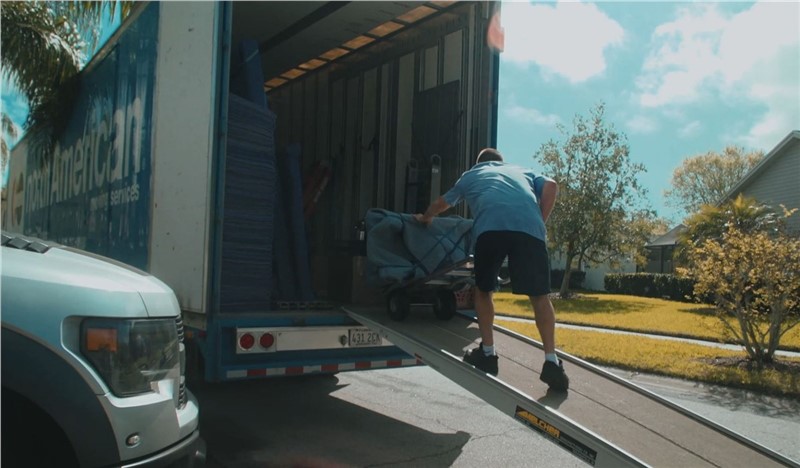Recognizing the Inclusions of moving and Freight Forwarding worldwide of Residential and Global Shipping
Guiding through the complexities of moving and Freight forwarding can be tough. Both processes entail unique procedures and requirements that are essential for successful transport. Recognizing the differences in logistics, documentation, and threat management is necessary for organizations and people alike. This understanding can significantly influence the effectiveness and safety of deliveries. Nevertheless, numerous are uninformed of the details components that influence the overall experience and end results. What elements should one think about to ensure a smooth changeover?
The Fundamentals of moving and Freight Forwarding
moving and Freight forwarding are essential parts of the international logistics sector. They promote the transfer of items and individual possessions throughout domestic and global borders. moving mostly involves the relocation of individuals or families, encompassing commercial and property needs. It generally includes packing, filling, transporting, and unpacking products at the destination. In contrast, Freight forwarding is concentrated on the delivery of goods, usually wholesale, making use of numerous transportation modes, such as land.freight, air, or sea forwarders work as middlemans, working with logistics to ensure timely delivery while steering through complicated regulations and personalizeds treatments. Both processes require careful preparation, organization, and interaction to assure effectiveness and reduce disruptions. Recognizing these basics is vital for any individual included in logistics, as they prepared for advanced facets of shipping and transportation monitoring.
Secret Elements of Freight Forwarding Solutions
Freight forwarding services encompass several vital parts that ensure smooth transport of items. Key responsibilities of Freight forwarders include managing logistics, working with deliveries, and taking care of customs clearance. Furthermore, understanding essential delivery documents is essential for conformity and reliable motion of cargo.
Freight Forwarder Responsibilities
A reliable Freight forwarder plays a necessary role in collaborating the transport of goods, making certain that shipments are managed efficiently and in compliance with policies. Their responsibilities include numerous key tasks, including choosing suitable transportation courses, negotiating Freight rates, and managing logistics. They serve as intermediaries between shippers and providers, making sure that cargo is appropriately packaged and labeled for risk-free transportation. Furthermore, Freight forwarders track deliveries, supplying updates to customers concerning the standing and expected shipment times. They also examine and manage dangers connected with transport, advising insurance coverage choices as required. By assisting in interaction and paperwork, Freight forwarders enhance the shipping procedure, decreasing possible delays and improving total supply chain effectiveness.
Delivering Documentation Fundamentals

Comprehending Personalizeds Clearance and Documents
Exact paperwork is vital in the personalizeds clearance process, as it guarantees compliance with numerous policies. A review of personalizeds policies highlights the intricacies dealt with by shippers and Freight forwarders. Usual clearance difficulties can significantly impact shipment timelines and costs, making understanding this aspect necessary for reliable logistics.
Importance of Accurate Documents
Guiding through the intricacies of international shipping calls for a keen understanding of customizeds clearance and the crucial role of documentation. Accurate documents is crucial for making certain that shipments abide by policies and reach their locations without hold-ups. Appropriately prepared documents, including bills of lading, industrial billings, and packaging checklists, promote smooth interactions with custom-mades authorities. Errors can lead to shipment delays, fines, and even confiscation of goods. In addition, detailed paperwork aids in monitoring deliveries and fixing disputes. Services engaged in moving and Freight forwarding must prioritize careful documentation techniques to navigate the complex landscape of worldwide delivery efficiently. This persistance not only simplifies operations however additionally improves customer fulfillment by guaranteeing prompt shipment.
Custom-mades Regulations Overview
Steering personalizeds laws is an important aspect of worldwide profession that straight impacts the success of moving and Freight forwarding operations. Effective personalizeds clearance requires an understanding of various laws, including tariffs, responsibilities, and import/export limitations. Accurate documents is crucial, as it ensures compliance with lawful demands and assists in the efficient activity of products across borders. Secret records often include commercial invoices, packing lists, and costs of lading, which supply thorough details concerning the shipment. Additionally, customizeds brokers play an essential duty in guiding intricate laws, working as middlemans in between shippers and customs authorities. By preserving complete expertise of personalizeds procedures, companies can substantially minimize delays and reduce costs related to global delivery.
Typical Clearance Challenges
Numerous obstacles can arise during the customs clearance process, often complicating the motion of items throughout boundaries. One considerable problem is insufficient paperwork, which can result in hold-ups and fines. Importers and merchants must ensure all needed documentation, such as billings, packing listings, and certifications of origin, is total and exact. Additionally, discrepancies in assessment can activate examination from customs authorities, leading to added responsibilities or assessments. Language obstacles might also posture difficulties, as miscommunication can bring about misunderstandings pertaining to policies. Moreover, modifications in custom-mades regulations can produce complication, necessitating continuous vigilance by carriers. Eventually, overcoming these clearance tests needs complete prep work and a clear understanding of customs demands to assist in smooth global transactions.
Packaging and Classifying Requirements
Although often overlooked, product packaging and labeling demands play a necessary function internet in the shipping procedure, making sure that goods are shielded and conveniently recognizable throughout their journey. Proper product packaging safeguards items from damages during transportation, while additionally helping with reliable handling and storage. Making use of suitable products, such as bubble wrap, foam, or strong boxes, can protect against damage and loss.Labeling is similarly essential. Exact and clear labels convey essential details, consisting of the destination, handling guidelines, and components. Labels need to abide with laws certain to domestic and international delivery, which may consist of unsafe products identification or customizeds declarations.Moreover, standard labeling techniques simplify the monitoring process and enhance general logistics efficiency. By adhering to packaging and labeling requirements, organizations minimize the risk of hold-ups, damage, or misdelivery. Eventually, these methods add greatly to the success of moving and Freight forwarding operations, guaranteeing a smooth delivery experience for all events entailed
Tracking Deliveries: Relevance and Methods
Effective packaging and labeling established the structure for effective shipment administration, however tracking deliveries is just as essential in the shipping procedure. Delivery monitoring gives real-time presence, which helps businesses and consumers monitor the development of their products. This transparency enhances customer contentment, since clients can remain informed regarding distribution timelines and any kind of potential delays.Several methods assist in effective tracking. Barcode scanning is a typical technique, making use of unique identifiers to keep an eye on plans throughout their journey. Additionally, general practitioner modern technology allows specific area monitoring, allowing for timely updates and enhanced logistics administration. Lots of delivery firms now provide electronic systems and mobile applications that give users with easy access to tracking information.The value of delivery monitoring can not be overemphasized; it minimizes the risk of shed or damaged items, enhances functional efficiency, and cultivates count on in between shippers and recipients. Consequently, integrating reliable tracking approaches is crucial for successful residential and international shipping procedures.
Insurance policy Options for Your Product

Securing insurance for items in transportation is a crucial consideration for organizations and individuals alike. Insurance choices differ based upon the sort of shipment, value of products, and details risks included. Usual types consist of service provider responsibility, which covers loss or damage while in transportation, and full-value insurance coverage, providing considerable protection for the total value of the goods.Shippers might likewise take into consideration marine insurance policy for international shipments, protecting against risks related to sea transportation. It is necessary to evaluate the specific requirements of the shipment and evaluate the conditions of any type of policy.Furthermore, understanding exemptions and constraints is vital to stay clear of potential gaps in insurance coverage. Shippers ought to involve with insurance coverage experts to check out tailored services that fit their distinct situations. Inevitably, spending in the ideal insurance coverage can alleviate monetary risks and offer satisfaction throughout the shipping process.
Choosing the Right moving and Freight Forwarding Solution
When choosing a moving and Freight forwarding service, it is vital for individuals and companies to carefully examine their certain demands and top priorities. Variables such as the volume of products, destination, and timeline play a substantial function in this decision-making process. Looking into different suppliers is suggested; comparing their services, rates, and client reviews can reveal important insights.Additionally, it is required to think about the experience and expertise of the service provider in handling particular kinds of freight, particularly for global shipments that might involve customs clearance. Openness in rates, consisting of any kind of concealed charges, should additionally be scrutinized.Furthermore, reviewing the level of consumer support used is vital, as timely communication can alleviate problems throughout transportation (international moving). Finally, confirming the accessibility of insurance options ensures that items are safeguarded throughout the delivery procedure. By taking these steps, services and people can make informed choices that line up with their logistics needs
Regularly Asked Inquiries
What Kinds Of Goods Can Be Shipped Worldwide?

Just How Do Shipping Prices Range Various Providers?
Shipping costs vary substantially in between service providers as a result of aspects such as service rate, cargo type, range, and additional solutions used. Each provider's rates model reflects these variables, influencing general shipping expenses for clients.
Can I Ship Hazardous Materials or Perishables?
Delivering hazardous products and perishables undergoes stringent regulations. Service providers usually need specific product packaging, labeling, and paperwork. Carriers need to guarantee conformity from this source with local and worldwide laws go to this web-site to avoid charges and assure safe transportation.
What Should I Do if My Shipment Is Delayed?
When encountered with a delivery hold-up, one should first call the copyright for updates. Examine any type of alerts received, evaluate alternate solutions, and keep all celebrations informed about the scenario to decrease disturbances.
Exist Weight Purview for Shipping Containers?
Weight restrictions for shipping containers vary depending upon variables like container dimension and shipping policies. Commonly, typical containers have a maximum gross weight of around 30,000 to 32,000 kgs to ensure risk-free transport and handling. In comparison, Freight forwarding is concentrated on the delivery of products, often in bulk, using various transportation modes, such as land.freight, air, or sea forwarders act as middlemans, coordinating logistics to guarantee timely delivery while maneuvering through facility policies and customs treatments. Secret responsibilities of Freight forwarders consist of taking care of logistics, collaborating deliveries, and handling customs clearance. A trustworthy Freight forwarder plays a crucial duty in coordinating the transportation of products, making sure that shipments are taken care of successfully and in compliance with guidelines. Efficient product packaging and labeling set the foundation for successful delivery administration, but tracking deliveries is similarly essential in the delivery process. Several shipping firms now provide digital systems and mobile applications that offer users with very easy access to tracking information.The importance of delivery monitoring can not be overstated; it decreases the danger of shed or harmed goods, improves operational effectiveness, and cultivates trust fund in between shippers and receivers.